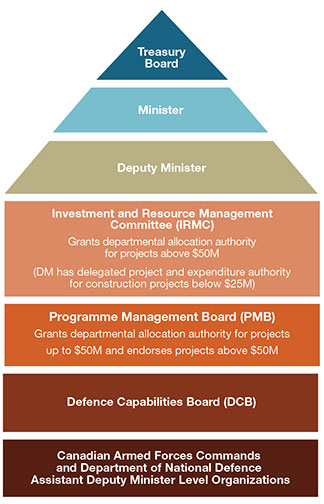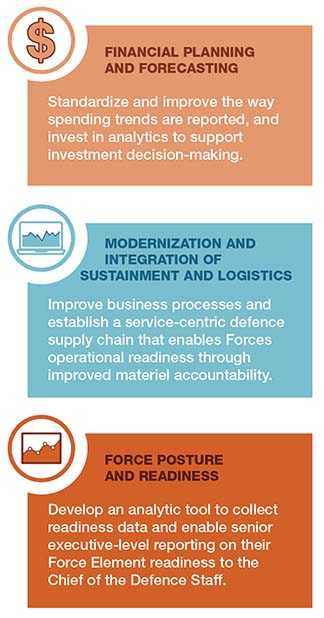Update 2019 | Transforming the way Defence works
2.1 Transforming the way Defence works
By analyzing and updating processes, National Defence is better able to execute projects, maintain timelines, and mitigate issues that could cause delays. A more streamlined approach facilitates management of the investment portfolio, efficient resource allocation, timely and informed decisions, and strengthened performance measurement, monitoring, and oversight of all projects. As seen in Defence Investment Plan 2018, the Defence Team is exploring what it can do better and what it should do differently. The Investment Plan communicates some important changes to how investments are approved and governed.
2.1.1 Streamlined governance
National Defence has improved its governance and oversight of investments to meet the priorities and objectives of investment planning. The processes and governance structures established to oversee this portfolio are appropriate for the complexity and risks associated with the investments. Since the publication of Defence Investment Plan 2018, National Defence has initiated several measures to improve its investment management and governance.
Recent changes to the Investment and Resource Management Committee include streamlined membership and adoption of a secretarial approval process to enable timelier decision-making. The Programme Management Board, which approves investment proposals between $5 million and $50 million, has seen some recent changes. These include standardizing the format for approvals to support informed decision-making as well as a more decision-oriented approach to enhance the focus on programme delivery.
Figure 1: Project Authority Approval Levels for Capital Projects

Figure 1 - Text version
The house-shaped illustration for the project authority approval levels for capital projects has seven blocks – four in the base and three in the peak.
The first block on the bottom shows the Canadian Armed Forces Commands and Department of National Defence Assistant Deputy Minister Level Organizations.
The second block shows the Defence Capabilities Board.
The third block shows the Programme Management Board (PMB), which evaluates all project proposals over $5 million and approves funding for projects up to $50 million. PMB also endorses projects over $50 million.
The fourth block, and final block of the base, shows the Investment and Resource Management Committee (IRMC), which approves funding for projects over $50 million.
The fifth block, and first in the peak, shows the Deputy Minister. The sixth and seventh blocks show the Minister and Treasury Board, respectively.
The Independent Review Panel for Defence Acquisition, while not part of the formal approval process, provides independent advice to the Minister of National Defence on all major procurement projects (valued at over $100 million), prior to seeking Treasury Board approval or exercising the Minister’s expenditure authority.
Of interest to industry partners, National Defence is reviewing, and adjusting as needed, the project approval process and supporting policy tools. The underlying principle is to reflect and support best practices in project management according to the type and complexity of projects.
Additionally, National Defence continues to improve its affordability assessment process that supports governance and decision-making. Affordability of the capital programme is assessed on the basis of 2 cost requirements: (1) acquisition and development; and (2) incremental operating, sustainment, and disposal. A source of funds is identified for each requirement prior to a project proceeding for approval by either the Minister of National Defence or Treasury Board.
2.1.2 Optimizing procurement
Strong, Secure, Engaged provided a road map for defence procurement by outlining Canada’s defence priorities and providing the funding necessary to meet those needs now and into the future. National Defence manages over 12,000 contracts and spends up to $6 billion dollars annually on its capital programme. These contracts range from small capital equipment projects to large, complex acquisitions. In May 2019, contracting authorities for competitive services contracts increased from $1 million to $5 million. This is a significant step in streamlining the procurement process, allowing National Defence to handle over 80% of contracts in-house.
Joint Support Ships
The Protecteur-class, future Joint Support Ships (JSS), will consist of 2 new replenishment ships for the Royal Canadian Navy. The JSS will support operations at sea and ashore — whether they are combat, humanitarian, or disaster relief. These ships will support Naval Task Groups by delivering fuel and other vital supplies to vessels at sea. They will also possess facilities for the operation and maintenance of helicopters as well as areas to offer personnel at sea medical and dental services.
Construction of the ships began in June 2018. In February 2019, the Government of Canada agreed to resequence the ship delivery schedule, which will result in the first JSS being delivered in 2023. At its peak, work on the JSS project will help sustain an estimated 1,000 highly skilled shipbuilding jobs in Canada.
Successful investment in defence capabilities is contingent on improving the way that National Defence does business. Overall, 90% of procurements are delivered within their planned scope and budget.
National Defence is also working with Public Services and Procurement Canada (PSPC) as it looks to accelerate procurement through a risk-based pilot project. This allows PSPC to execute low-risk, low-complexity contracts on behalf of National Defence without going to Treasury Board.
Overall, National Defence is updating its procurement processes to reflect that “one size does not fit all.” Instead, National Defence will execute the best procurement process for each project or contract, ensuring the best strategy is selected.
A key feature of the majority of projects and contracts is the Government of Canada’s Industrial and Technological Benefits Policy (ITB). This policy requires that for every dollar the government spends on major defence purchases, the winning contractor must put a dollar back into the Canadian economy. Through the ITB Policy, Canada has seen the creation of new jobs and increased economic growth.
Willow Park Armoury
Through Strong, Secure, Engaged, the Government is investing in a strong and capable Reserve Force. Completed in August 2018, the new Willow Park Armoury in Halifax is now home to three Army Reserve units and a recruitment office. It is also demonstrative of the Government of Canada’s investment in modern, functional, and green defence infrastructure.
The project was completed on time and under budget, and provided significant economic opportunities for the local Halifax community by creating an estimated 250 jobs during construction.
2.1.3 Gender-based Analysis Plus
Strong, Secure, Engaged makes a firm and public commitment to integrate Gender-based Analysis Plus (GBA+) in all Defence activities. This includes the hundreds of projects and contracts outlined in Defence Investment Plan 2018. National Defence continues to work hard to ensure that the Defence Team is trained in applying GBA+ to integrate gender and diversity perspectives effectively in decision-making across all business lines. Since 2018, the Joint Responsibility Centre for GBA+ has provided strategic advice to numerous investment projects, resulting in real changes to how National Defence procures materiel, designs infrastructure and information management projects, and enhances and modernizes military capabilities. For example, GBA+ is also used in combination with the Canadian Forces Anthropometric Survey data to ensure that the human-machine interface with vehicles and equipment is considered in a manner that accommodates the wide diversity in body shapes, weights, and sizes of Canadian Armed Forces members.
The Defence Team is using GBA+ to support economic opportunities for women, visible minorities, and Indigenous peoples. This is achieved through several means, including the consideration of supplier diversity, identifying opportunities to adapt procurement procedures, and encouraging suppliers to provide gender and diversity plans when bidding on projects. National Defence continues to work with other federal government partners to identify further mechanisms that can be put in place to encourage the defence industry to reduce inequality in their own workforces.
2.1.4 Data and analytics
National Defence is exploring the use of new analytic technologies to model investment portfolio impacts better. These technologies will allow for qualitative assessments of the impact of changes in economic factors, scheduling, and scope on the entire portfolio.
To drive this modernization and become more data-driven, National Defence has appointed a senior executive to lead Data, Innovation and Analytics. This organization drives collaboration across National Defence and with other federal departments and agencies. In addition to enabling improved business intelligence, providing a gateway to digital transformation, and support to operations, new analytics tools, as illustrated in Figure 2, will enable better modeling of investment portfolio impacts.
Figure 2: Defence Analytics Initiatives

Figure 2 - Text version
The topmost box – of three vertically stacked boxes – has a money sign icon in the upper left hand corner. This box explains financial planning and forecasting, which is to standardize and improve the way spending trends are reported, and invest in analytics to support investment decision-making.
The second box has a laptop icon in the upper left hand corner. This box explains modernization and integration of sustainment and logistics, which works to improve business processes and establish a service-centric defence supply chain that enables Forces operational readiness through improved materiel accountability.
The third box has a graph icon in the upper left hand corner. This box explains Force posture and readiness, which looks to develop an analytic tool to collect readiness data and enable senior executive level reporting on their Force Element readiness to the Chief of the Defence Staff.
Table of contents
Page details
- Date modified: